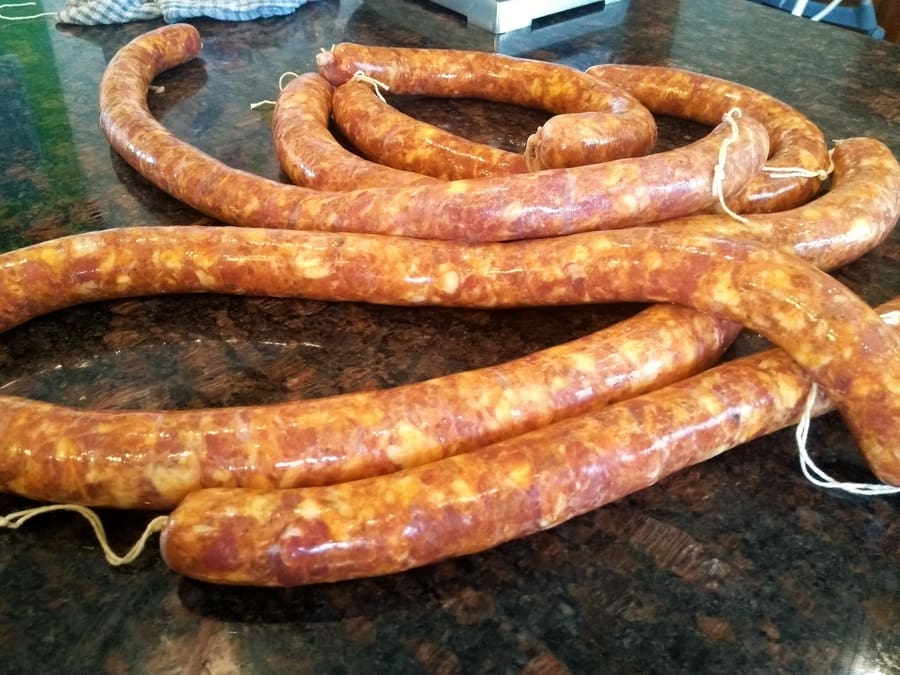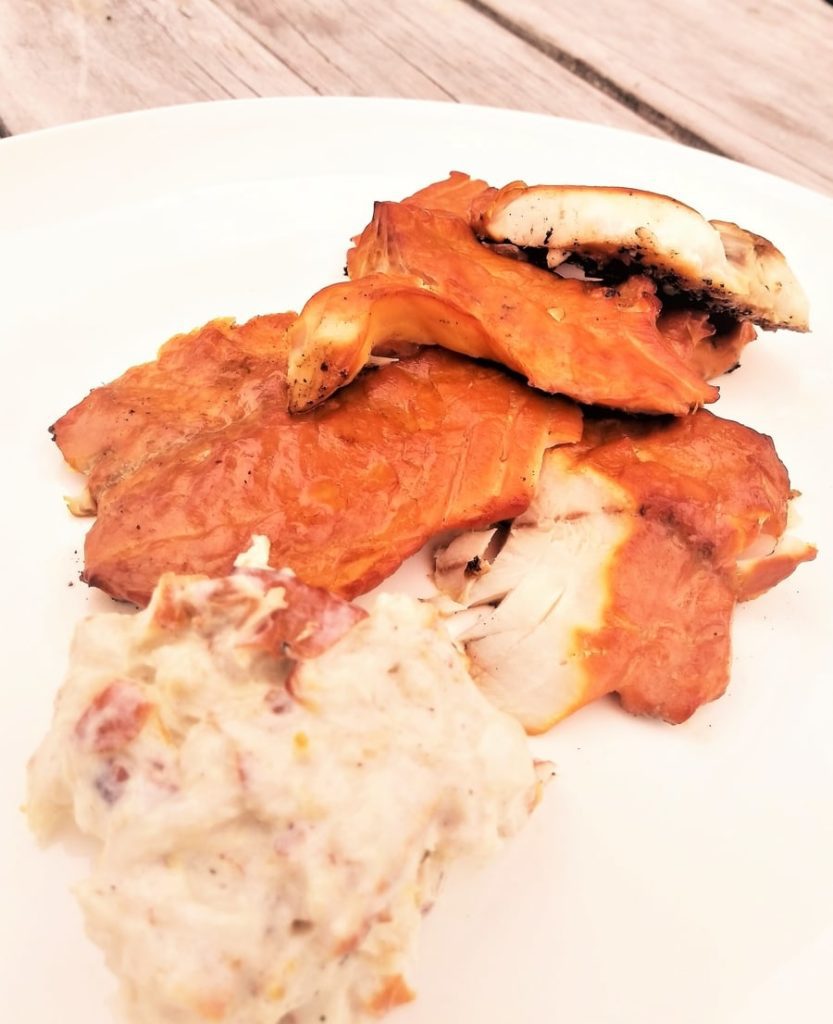It’s a fascinating world when you start making charcuterie at home; there are many ways how to go about it, and, of course, it depends on what you want to have a go with.
Charcuterie Projects Difficulty and Duration
| Project | Difficulty | Duration |
| Pate /Rillettes | 2/10 | 2-4 hours |
| Vegetable Preserves/Flavoring | 2/10 | 15-60 mins |
| Cold Smoke Vegetables | 3/10 | 30-60 mins |
| Hot Smoked Fish, Meat | 4/10 | 4-16 hours |
| Fresh Sausages | 4/10 | 4 – 8 hours |
| Dry Curing Meat in a Regular Fridge | 5/10 | 7-30 days |
| Cold Smoked Meat | 6/10 | 1 – 3 weeks |
| Dry Cured (Hung) | 7/10 | 2 weeks – 24 months |
| Dry Cured Salami & Emulsified | 7/10 | 3 weeks – 24 months |
Many of the techniques are ancient and bathed in history, and I mean ancient history (Roman times for prosciutto, for instance—pork, salt, time, and a cool moisture environment—oh, and incredible passion and food culture help).
I have been exploring various charcuterie and meat-curing styles for the last few decades. As the world melds together, the different charcuterie styles are merging. It’s super exciting to be a part of this.
Here is a quick breakdown of easy to more in-depth projects. Quite a few of the projects at the bottom of the table are long-term and or need some dedication – the outcomes can be spectacular. Charcuterie is the ultimate slow food!

Of course, these are generalizations about the time and effort – I hope it helps someone new to charcuterie.
I thought it would be helpful to see the many options available for curing, picking, or smoking something at home.
What Does Dry Cured Mean?

Dry-cured meats are a big part of charcuterie, and the charcuterie board has become very popular. It uses a dry salt cure to draw moisture out and intensify the flavor (if you are interested in discovering why I think charcuterie has become so popular, check out this post).
Most folks know about dry-cured bacon since it’s so popular. They use a dry salt cure before cold smoking (sometimes hot smoking aspects).
So all the glories of prosciutto, braesola, lonza, pancetta & coppa – are all classic Italian dry cured meats.
Of course, hanging smaller bits of meat is much easier than going for a full leg of prosciutto pork. Having a curing chamber is not essential, but it does help if you get seriously into it.
So, what Charcuterie do you want to start with?
For a first time at charcuterie, I would suggest something like these,
- Rillette – preserving in fat
- Hot Smoking Fish, Sausages in a Portable Smoker
- Preserving or flavor-enhancing some Vegetables or Olives for a Charcuterie Platter

Gear or Tools for Charcuterie
You may already have what you need for pickling or rillettes; decent jars are about it, plus the food ingredients. You are cooking rather than placing meat in a jar or ramekin.
A simple portable smoker, an outdoor heat source, and some smoking wood are all you need to do simple direct hot smoking. I have used a portable camping smoker for a very long time – a simple device that produces a whole different angle on flavor.
Indoor smokers are also coming to the market.
Here is a hot smoking guide I wrote, and also smoking fish on a gas grill BBQ.
Buying plain olives and throwing in some herbs, garlic, or spices can create a whole new level of appreciation. Quickly pickling cucumbers is another easy addition to a charcuterie platter.
Let me go into some detail about these; for starter options, I will put some links below to other more in-depth options you might want to read about.
Techniques Overview
Steps to Make a French Meat Rillette
- Cook the meat until tender
- Add and mix some desired spices, herbs, etc
- place in ramekin or jar and cover with fat
- Make sure meat is covered in fat (duck fat is common)
- Remove and smear on toast to enjoy
Here is an easy pork rillette recipe from the NY Times,
Steps to Make Liver Pate
- Cook liver with spices and flavors
- blend up until it is fine
- Put in jar with butter on top to seal and block oxygen
Here is a chicken liver pate recipe from drizzle and dip that you will love.
Marinating or Quick Pickling Vegetables
It is such a great addition to the charcuterie board; one of my favorites is to choose a basic brined jar of olives from the grocer, then throw some ‘hard’ herbs like rosemary in with slivers of garlic and cracked pepper.
It gives a flavor bomb to those olives! You can customize it to any flavor you like.
Simple pickling vegetables contrasts and cuts through the fat of dry cured meat like prosciutto or pancetta. I find it refreshes the palate, and cheese and pickles are classics as well.
Pickled Cucumber: here is a bunch of recipes on the quickest of pickles!
Dry Cured Meat Charcuterie in a Regular Fridge

I have been trialing this technique a fair bit. The key to success is the minimal amount of fat and under 7 oz / 200 grams of meat. It is an excellent way to introduce the idea of ‘preserving’ a small bit of beef, venison, or pork.
To be thinly sliced and appreciated with loved ones.
I wrote a comprehensive post here on charcuterie dry curing in a kitchen fridge if you want more information.
Cold Smoked Charcuterie Meat
Not sure why so many people see cold smoking as being complicated; it’s doesn’t take much kit, and the key is to have something that is fully cured, cold smoked in reasonably high humidity and cool temperature (at night works well in my area during the warmer months.
If you want to get your head around trying some delicious homemade cold-smoked charcuterie, check out a full post I wrote here on how to cold smoke.
Making Dry Cured Meats in a Curing Chamber
You can get the right environment initially, but it will require some trial and error.
Building a curing chamber is the way to go. If you want a full rundown on the equipment you need, I wrote a full breakdown to help guide those wanting to put together a curing chamber. It starts with an old fridge or wine fridge, generally.
Check out how to build a curing chamber here.
The gest is that you need to control the humidity and temperature – then keep those bugs off and create beautiful dry cured meats.
Salami & Salumi
If you want to get into this, I wrote a post just going over the subtle difference between these classic types of Italian meat curing here.
Wild Game vs. Farmed
For fish that caught or meat that I harvest, I like to make an extra effort – since it usually takes extra effort to procure.
Cold Smoking – Full Guide I wrote
Dry Curing Meat in a Regular Fridge – step by step
Dry Curing with salt – different techniques
Cold Smoking can be done quickly on your gas grill BBQ with a small cold smoke-generating device.
You can use just salt and spices with the meat for dry-cured charcuterie in your regular kitchen fridge. However, nowadays, it is a good idea to use pink curing salt (for under 30 days of curing – pink curing salt No. 1 is the way to go).
Long-term Dry Curing and salami making can be done with some DIY hacking, but I always recommend doing it properly if that’s what you want to get into. In saying that, you will want to get the basics done first.

Tom Mueller
For decades, immersed in studying, working, learning, and teaching the craft of meat curing, sharing the passion and showcasing the world of charcuterie and smoked meat. Read More
